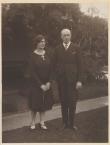Joan Lindsay grew up in her birthplace of East St Kilda in Victoria. Her father was Sir Theyre Weigall, while her mother, Annie Sophie Henrietta (aka A. S. H. Weigall, q.v.), was the daughter of the Governor of Tasmania, Sir Robert Hamilton. Lindsay attended Clyde Girls Grammar School in St Kilda, which became the model for Appelyard College in Picnic at Hanging Rock. From 1916 to 1920 she studied painting at the National Gallery of Victoria, where she shared a studio with Maie Casey, with whom she had a lifelong friendship. Lindsay was a promising artist and in 1921 exhibited for the first time with the Victorian Artists Society. On St Valentine's Day, 1922 in London, she married Daryl Lindsay (q.v.), artist and member of the famous Lindsay family.
In 1936 Lindsay published a parody, Through Darkest Pondelayo, under the pseudonym Serena Livingstone-Stanley. At about the same time she was writing plays and although they were not published, one of them, Wolf (written with Margot Neville, q.v.) was performed in Swanage, England, in 1930. In 1941 her husband was appointed Director of the National Gallery of Victoria, a position he held until 1956, the same year in which he received a knighthood. In 1941 Lindsay and her husband collaborated in the writing of The Story of the Red Cross. During the next few years Lindsay was joint author with Ursula Hoff and Alan McCulloch of Masterpieces of the National Gallery of Victoria (1949) and co-edited Early Melbourne Architecture, 1840-1888, with Maie Casey and others. She also joined with Maie Casey, Rosemary Dobson and Marnie Bassett in writing the words of A Company of Carols, which was set to music by Margaret Sutherland (1967).
Joan and Daryl Lindsay lived most of their married life at Mulberry Hill, Baxter, Victoria, which is now owned by the National Trust. Her neighbours and close friends were Keith Murdoch (q.v.) and Elisabeth Murdoch. Another close friend was her cousin Martin Boyd (q.v.) and she was particularly influential in the genesis of his novel Nuns in Jeopardy (1940). Her sister, Marian Weigall (q.v.), published poetry, while her brother Theyre Hamilton Weigall (q.v.) was the author of a novel. At Mulberry Hill Joan Lindsay wrote her autobiographical works Time Without Clocks (1962) and Facts Soft and Hard (1964), as well as her most famous book, Picnic at Hanging Rock (1967), which was later made into an internationally acclaimed film by Peter Weir. Her last book was the children's story Syd Sixpence (1982).
Note: Writing as A. S. H. Weigall, Joan Lindsay's mother published an autobiography My Little World: Recalled (1934); after Theyre Weigall's death, A.S.H. Weigall married T. G. Tucker (q.v.), whom Joan Lindsay greatly admired.


